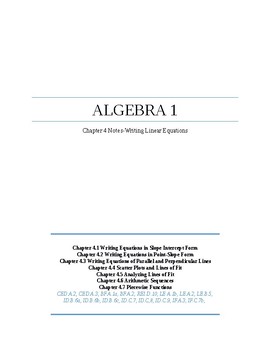Writing Linear Equations~Alg 1 Ch 4 Student Notes~Big Ideas Textbook Aligned
Hernandez Math Hero
34 Followers
Grade Levels
7th - 11th
Subjects
Resource Type
Standards
CCSSHSA-CED.A.2
CCSSHSA-CED.A.3
CCSSHSA-REI.D.10
CCSSHSF-IF.A.3
CCSSHSF-IF.C.7d
Formats Included
- Word Document File
Pages
32 pages
Hernandez Math Hero
34 Followers
What educators are saying
Use these notes with my 8th grade Algebra students. I have to make a few changes since I am using a newer version of the Big Ideas text book.
Also included in
- Here are all the student notes I use for the Big Ideas Algebra 1 Book. I did not create chapter 10 student notes but I will work on that.Price $78.40Original Price $98.00Save $19.60
Description
The Algebra 1 Chapter 4 Guided Notes aligns with the Big Ideas Textbook. The guided notes are put together in order to cut down on time in class simply writing down the problems. There are Bell work and Exit Card questions in most sections.
Total Pages
32 pages
Answer Key
N/A
Teaching Duration
2 Weeks
Last updated May 25th, 2017
Report this resource to TPT
Reported resources will be reviewed by our team. Report this resource to let us know if this resource violates TPT’s content guidelines.
Standards
to see state-specific standards (only available in the US).
CCSSHSA-CED.A.2
Create equations in two or more variables to represent relationships between quantities; graph equations on coordinate axes with labels and scales.
CCSSHSA-CED.A.3
Represent constraints by equations or inequalities, and by systems of equations and/or inequalities, and interpret solutions as viable or non-viable options in a modeling context. For example, represent inequalities describing nutritional and cost constraints on combinations of different foods.
CCSSHSA-REI.D.10
Understand that the graph of an equation in two variables is the set of all its solutions plotted in the coordinate plane, often forming a curve (which could be a line).
CCSSHSF-IF.A.3
Recognize that sequences are functions, sometimes defined recursively, whose domain is a subset of the integers. For example, the Fibonacci sequence is defined recursively by 𝘧(0) = 𝘧(1) = 1, 𝘧(𝘯+1) = 𝘧(𝘯) + 𝘧(𝘯-1) for 𝘯 greater than or equal to 1.
CCSSHSF-IF.C.7d
Graph rational functions, identifying zeros and asymptotes when suitable factorizations are available, and showing end behavior.






